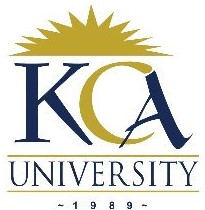 UNIVERSITY EXAMINATIONS: 2017/2018
UNIVERSITY EXAMINATIONS: 2017/2018
EXAMINATION FOR THE DEGREE OF BACHELOR OF SCIENCE IN
INFORMATION TECHNOLOGY/ BACHELOR OF SCIENCE IN
INFORMATION AND COMMUNICATIONS TECHNOLOGY
BIT3107 BCT3101 WIRELESS NETWORKS TECHNOLOGIES
FULL TIME/PART TIME/DISTANCE LEARNING
DATE: APRIL, 2018 TIME: 2 HOURS
INSTRUCTIONS: Answer Question One & ANY OTHER TWO questions.
QUESTION ONE [30 MARKS]
a) (i) Describe briefly the Bluetooth technology. 3 Marks
(ii) State any five prevalent applications of Bluetooth. 5 Marks
b) Define the following terminologies as used in WLANs
(i) Beacons 1 Mark
(ii) Probes 1 Mark
(iii) Authentication 1 Mark
(iv) Association 1 Mark
c) (i) Differentiate between Fixed-assignment multiple access (FAMA) and Demandassignment multiple access (DAMA) 2 Marks
(ii) Describe a typical GEO satellite frequency allocation 2 Marks
d) Discuss the three major factors that influence the transmission of radio waves.
6 Marks
e) PCM (Pulse Code Modulation) is the process in which a signal is sampled, and the
magnitude of the each sample with respect to a fixed reference is quantized and converted
by coding to a digital signal.
(i) Define sampling, quantization and encoding. 3 Marks
(ii) State Nyquist Sampling Theorem 2 Marks
f) Why is multiplexing widely used in Wireless Networks? 3 Marks
QUESTION TWO [20 MARKS]
a) Explain at least three (3) benefits which result from migration from analog to digital
transmission. 6 Marks
b) “Frequency borrowing”, “Cell splitting” and “Cell sectoring” are approaches used in
cellular wireless networks to cope with increasing capacity demand for a cell. Explain
these approaches. 6 Marks
c) What determines how successful a receiver will be in interpreting an incoming signal?
Briefly explain. 6 Marks
d) What makes it difficult to jam signals transmitted in a spread spectrum technique?
2 Marks
QUESTION THREE [20 MARKS]
a) State four characteristics of GPRS. 4 Marks
b) Each GSM radio transceiver uses Time Division Multiplexing to deliver eight voice
circuits on one radio channel. Each radio site may have one or more transceivers to provide
sufficient channels to end users. State four factors that limit the maximum numbers.
4 Marks
c) State four applications particularly suited to GPRS. 4 Marks
d) Explain the functions of the following components of RFID:
(i) Antenna 2 Marks
(ii) Active Tags 2 Marks
(iii) Passive Tags 2 Marks
(iv) Readers 2 Marks
QUESTION FOUR [20 MARKS]
a) State four rules that apply to radio frequency transmission in relation to frequency, range
and data rate. 4 Marks
b) WLAN clients have the ability to shift data rates while moving. Explain this concept in
detail and its importance in relation to IEEE 802.11b standard. 6 Marks
c) An antenna is defined as an electrical conductor or system of conductors that are used for
transmitting and receiving electromagnetic energy. Briefly discuss the three (3) main types of
antennas. 6 Marks
d) State the main characteristics of the following standards:
(i) 802.11d 1 Mark
(ii) 802.11e 1 Mark
(iii) 802.11i 1 Mark
(iv) 802.11h 1 Mark
QUESTION FIVE [20 MARKS]
a) (i) Explain briefly two similarities between WLANs and LANs. 2 Marks
(ii) Explain briefly four differences between WLANs and LANs. 4 Marks
b) Wireless Application Protocol (WAP) is the de facto world-wide standard for providing
Internet communications and advanced telephony services on digital mobile phones, pagers,
PDAs and other wireless terminals. With the aid of a diagram, explain how this works.
8 Marks
c) Explain any three benefits of wireless solutions. 6 Marks
